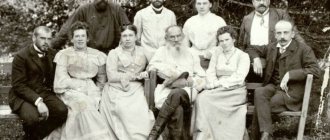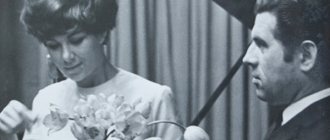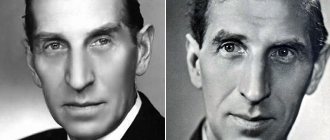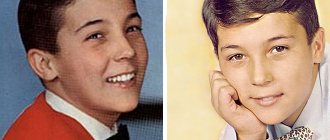Alexey Nikolaevich Tolstoy is a Russian and Soviet writer, poet, playwright, screenwriter, journalist and public figure. For his biography, Tolstoy was awarded 3 Stalin Prizes.
He was amenable to a variety of literary genres, but most of his works were written in the spirit of social realism and science fiction.
There are many interesting and controversial points in the biography of Alexei Tolstoy, which we will tell you about right now.
So, here is a short biography of Alexei Tolstoy.
Biography of Alexei Tolstoy
Alexei Tolstoy was born on January 10, 1883 in the city of Nikolaevsk, Samara province. Biographers still argue about who his father was.
According to the generally accepted version, he was Count Nikolai Tolstoy. Other biographers attribute paternity to Alexei Bostrom, who was the boy’s stepfather.
When the mother of the future writer, Alexandra Leontyevna, was pregnant with her fourth child, Alexei, she left the wealthy Count Tolstoy for Bostrom. At the same time, the woman left all three children to her husband. It is for this reason that historians believe that the writer’s father was Alexei Bostrom.
Childhood and youth
Until the age of 13, Tolstoy bore his stepfather's surname and called him dad.
17-year-old Alexei Tolstoy (Samara, 1900)
An interesting fact is that Alexandra Leontyevna was never able to legitimize her relationship with Bostrom, since it went against church traditions.
For many years, the mother did everything possible to ensure that her son received the title of count and the surname of her ex-husband. As a result, only in 1901 the young man became Count Tolstoy.
In the first years of his biography, little Alyosha was educated at home. From an early age, my mother instilled in her son a love of literature (see interesting facts about literature).
In 1897, the family moved to Samara, where Tolstoy entered a real school. After 4 years, he continued his studies at the St. Petersburg Institute of Technology.
Interesting Facts
- A. N. Tolstoy was included in the government commission for organizing the funeral of A. M. Gorky. From Rybinsk, where the writer had previously scheduled an evening for his meeting with readers on June 20, Alexei Tolstoy was flown to Moscow. On June 20, 1936, together with members of the government commission, Alexey Tolstoy carried an urn with the ashes of A.M. across Red Square. Gorky.
- “The Red Count” was the name of the Soviet writer Alexei Nikolaevich Tolstoy. The former emigrant and titled nobleman managed not only to overcome all the obstacles of the new regime, but also to become the favorite and darling of the Soviet regime - the Stalinist prizes and the prosperous life of the writer, which differed little in terms of comfort from the pre-revolutionary one, serve as indisputable confirmation of his special position in the USSR. Almost immediately, Tolstoy the writer found himself among Stalin’s personal friends. He was made a member of the Academy of Sciences, he was also listed as a deputy of the Supreme Council of the Soviet Union, had a luxurious dacha in Barvikha and a car with a personal driver.
- Alexei Tolstoy’s science fiction novel “Engineer Garin’s Hyperboloid” was inspired by the public outcry caused by the construction of the Shukhov Tower. The image of the Shukhov Tower became the logo of the exhibition “Engineering Art” at the Pompidou Center in Paris. Also, a six-meter model of the tower was installed at the exhibition “The best designs and structures in the architecture of the 20th century” in Munich in 2003.
Literature
The first collection of poetry in the creative biography of Alexei Tolstoy was “Lyrics,” published in 1907. Literary critics noticed the influence of Nikolai Nekrasov and Semyon Nadson in the poems of the young poet. Later, the author of “Lyrics” was ashamed of his collection and did not like to talk about it.
That same year, Alexei Tolstoy dropped out of college to pursue writing. In 1908, the first story in Tolstoy’s biography, “The Old Tower,” was published, written under the impression of a trip to the Urals. Having lived there for about 2 months, he learned from the local population many interesting tales, epics and the like.
During the biography of 1910-1911. Alexei Tolstoy wrote 7 novellas and short stories, among which were “Arkhip”, “Matchmaking” and “Mishuka Nalymov” from the collection “Trans-Volga Region”.
An interesting fact is that Maxim Gorky left very good reviews about “Zavolzhye”, while the writer himself spoke negatively about the collection.
More than fifty interesting fairy tales came from the pen of Alexey Tolstoy, many of which were later filmed. Most of them were written in the writer’s youth. Tolstoy also wrote many stories (which came surprisingly easily to him) and composed dozens of plays that were successfully staged at the Maly Theater.
In 1911, the first novel in the biography of Alexei Tolstoy, “Cranks,” was published. The following year he wrote his second novel, The Lame Master. Soon the measured life of the writer was disrupted by the First World War (1914-1918).
At this time, Alexei Tolstoy worked as a military journalist. He wrote articles for the publication Russkie Vedomosti, and also published the stories “Love”, “Beautiful Lady” and “An Ordinary Man”.
Alexey Tolstoy in his youth
Tolstoy accepted the October Revolution of 1917 without any enthusiasm. The very next year he moved to live in Odessa, fleeing the Bolsheviks. An interesting fact is that it was in this city that he created his famous story “Count Cagliostro”.
Soon, Alexey Nikolaevich and his family emigrated first to Constantinople, and then to the capital of France, where he began working on his famous trilogy “Walking in Torment”.
In 1921, the Tolstoy family again changed their place of residence. This time they moved to Berlin. However, all this time the writer was nostalgic for his native places, and therefore already in 1923 he decided to return to Russia.
The return of Alexei Tolstoy caused a stormy reaction in society. Many called him a traitor and advised the “count” to go back. Nevertheless, the Bolsheviks reacted favorably to his return.
Soon Tolstoy developed a personal relationship with Joseph Stalin, which had a positive impact on his future biography. The writer was often invited to various social events, where leading party and cultural figures gathered.
Later, Alexei Tolstoy became a member of the Academy of Sciences and was elected to the Supreme Soviet of the USSR. In addition, he was given a dacha in Barvikha and given car keys. All conditions were created for him to feel comfortable and not need anything.
In 1936, the fairy tale “The Golden Key, or the Adventures of Pinocchio” came out from the pen of Tolstoy. She immediately gained enormous popularity throughout the Soviet Union. After this, he published his famous works “Bread” and “Peter the Great”.
An interesting fact is that the last novel aroused admiration even from Ivan Bunin, who was skeptical about the work of the “count”.
Alexey Tolstoy at work
In the biography of Alexei Tolstoy there are works that were attributed to him, and from which he categorically disowned. These include the frank story “Bathhouse,” called the first erotic work of pre-revolutionary Russia.
However, this information should be treated with caution. A number of literary scholars suggest that “Bathhouse” could have been written by Leo Tolstoy or Nikolai Leskov.
It is worth noting that many colleagues in the shop did not like Alexei Tolstoy because he never went against the ideas of the party. Over the years of his creative biography, he often praised Stalin and other party leaders.
Alexey Tolstoy and Mikhail Sholokhov
Despite this, his works became classics of Soviet literature during his lifetime. The following works received the most popularity:
- “The Adventures of Nevzorov, or Ibicus”;
- "Aelita";
- “Hyperboloid of Engineer Garin”;
- "The Road to Calvary";
- "Peter the First".
About Duels, Monkey Tails and New Countesses
He did not come from Dresden alone and was in love even more than he had once been with Yulia. Sonya Dymshits, a modernist artist, she seemed extraordinary and always talked about interesting things. “Do you like to listen to rain at night? It’s like little spirits slapping their bare feet on the ground.” Yulia agreed to give a divorce: “Since you intend to devote yourself entirely to art, Sofya Isaakovna is much more suitable for you.” But Sonya's husband was not so accommodating. This did not allow the lovers to get married, but could not prevent them from living together. “My wife, Countess Tolstaya,” Alexey Nikolaevich introduced Mrs. Dymshits everywhere.
Sonya Dymshits visiting Voloshin in Koktebel, 1909
Soon Sonya gave birth to a daughter, Marianna. This time Tolstoy was not burdened with worries about the child - the girl was entrusted to her grandmothers and aunts. And the young parents surrendered themselves to the joys of creativity. Tolstoy tried himself in different genres: poetry, plays, children's fairy tales. He wrote them down in thick notebooks lined with black oilcloth, simply titled: “1904”, “1905” and so on. Listened to lectures by Vyacheslav Ivanov and Innokenty Annensky at the Academy of Verse. He became a second in the duel between Voloshin and Gumilyov. And, most importantly, he and his friends organized the artistic cafe “Stray Dog” - that legendary place where, according to the apt formulation of the futurist poet Benedict Livshits, “the division of humanity into two unequal categories took place: into representatives of art and into “pharmacists”, under which meant all other people, whatever they did and whatever profession they belonged to.” Where “draped in black silk, with a large oval cameo at her waist, Akhmatova floated in, lingering at the entrance so that, at the insistence of Pronin, who rushed to meet her, she could write her last poems in the “pork” book, based on which the simple-minded “pharmacists” made guesses that tickled their curiosity . In a long frock coat and a black regatta, not leaving a single beautiful woman unattended, Gumilyov retreated, backing between the tables, either thus observing court etiquette, or fearing a “dagger gaze in the back”... In “Stray Dog” the walls were completely painted (by artist Sudeikin). Something always happened in “Stray Dog”: for example, someone poured a bottle of wine on the head of the poet Balmont... “Stray Dog” was, perhaps, the best work of Alexei Tolstoy, even if it was created in collaboration.
In "Stray Dog"
The new Countess Tolstaya took an active part in her husband’s undertakings, and the names of the eccentric couple did not leave the pages of gossip columns. But one day the Tolstoys went too far - at a costume ball hosted by Fyodor Sologub, where the cheerful count, by the way, appeared dressed as a “woman in the dressing room”: in a woman’s undershirt, with a broom and a gang. In the midst of the fun, Alexey Nikolaevich for some reason looked into the owner’s office. There was no one there, but monkey skins were found. Sonya, having heard about the skins, suggested cutting off the tails from them and organizing a “dance of demons.” The Tolstoys did not bother to ask permission from Sologub. And then it turned out that these skins ended up here by accident, they are very rare and belong to a scientist who values them extremely. Sologub got it hard from the scientist, and Tolstoy from Sologub: he announced that he would not publish his poems in the same magazines as the hooligan Count, and Alexey Nikolaevich became an unpublished author. I had to move from St. Petersburg to Moscow - they weren’t afraid of Sologub there. In Moscow, life flowed much more measuredly and boringly. Sonya became depressed and got ready to go to Paris to improve her painting skills. “I feel that you are leaving me forever,” Tolstoy complained. She remained silent. However, when Sonya returned to Russia a year later, Alexei Nikolaevich had a new romance - with the 17-year-old ballerina Margot Kandaurova, thin and lovely. Together they spent a wonderful summer with half-naked “stupid boys” at Voloshin’s. And in the fall, in parallel with this, Tolstoy began another affair - with a married lady, 26-year-old Natalya Krandievskaya-Wolkenstein.
Tolsty at Voloshin's in Koktebel
That year, a world war broke out in Russia. Krandievskaya was assigned as a nurse to the infirmary at the Racing Society. Tolstoy once came there on business, reported two pieces of news: he was going to the front as a correspondent for Russkie Vedomosti and finally broke up with Sofia Isaakovna. He didn’t say a word about proposing to Kandaurova. Krandievskaya later found out from friends. And she was surprised when Tolstoy, as soon as he arrived on vacation, immediately rushed to visit her in the infirmary. He was wearing a military jacket, civilian trousers and tennis shoes: “A suit for kidnapping women. And I start with you." Krandievskaya coldly congratulated him on his upcoming wedding. “Oh, you’ve already been informed...” the count waved him off frivolously. - I don’t even understand how to explain. Margarita is not a woman, she is a flower. Lunar obsession. And it’s unclear to me how to put all this into the form of marriage.”
Margarita Kandaurova
Now in the evenings Tolstoy met Margarita at the Bolshoi, took her home, and at night he knocked on the door of the Krandievskys, where Natalya Vasilievna and her sister Duna were waiting for him. We drank tea and had fun. Dune painted, Natasha played the piano charmingly and sang wonderfully. Her blue eyes glowed affectionately, her gentle blush was red like a girl’s, and she exuded calm and comfort. “You are a tender cherry,” Alexey Nikolaevich whispered in Natasha’s ear when they were alone for a while.
Natalya Krandievskaya with her son Fedor
One day Tolstoy brought Margarita to the Krandievskys. He himself talked a lot, made jokes, and sprinkled jokes. Natasha’s husband, lawyer Wolkenstein, looked at the guests arrogantly and unkindly. Margarita sat with her eyes downcast and shuddered at Tolstoy’s noisy exclamations. And Natalya was painfully wondering: what kind of confrontation is this and what will it lead to? Soon the situation resolved itself: Margarita broke off the engagement, the offended Tolstoy removed the dedication to her from the next book of stories and moved on to decisive action with Natalya. It all happened in December 1914. “Natasha, my soul, my beloved, I know: what happened today is forever,” Tolstoy wrote to her. “If you stop loving me and leave me, I will die.” In Moscow they didn’t even have time to understand that Tolstoy was preparing to marry someone other than the one he had planned to marry. One venerable general, godfather of Margot Kandaurova, stopped by Alexei Nikolaevich to congratulate his goddaughter on her upcoming marriage. And when he met Natalya Krandievskaya in the living room, he threw up his hands: “Margarita, how you have grown, how you have changed! But why did your eyes turn from black to blue?”
Personal life
There were 4 women in the biography of Alexei Tolstoy. His first wife was Yulia Rozhanskaya, whom he met at a theater rehearsal. The young people began dating, and in 1902 they decided to get married. Soon they had a boy, Yuri, who died in early childhood. In 1910 the couple decided to divorce.
Later, Tolstoy went to Germany, where he drew attention to the avant-garde artist Sofya Dymshits. The Jewish woman Sophia agreed to become the writer’s wife and even converted to Orthodoxy. In 1911, their girl Marianna was born.
Then Alexei Tolstoy began an affair with the poetess Natalya Krandievskaya. For this reason, he left Sophia and in 1914 married Natalya. In this union, 2 sons were born - Nikita and Dmitry. The marriage lasted 21 years.
A. N. Tolstoy and his fourth wife L. I. Tolstaya (Krestinskaya). Barvikha, 1943
The reason for the third divorce was the young secretary Lyudmila Krestinskaya-Barsheva.
Tolstoy fell madly in love with a girl who was 23 years younger than him. As a result, Alexey Nikolaevich tied the knot for the 4th time, living with his new wife until the end of his days.
About a porcelain teapot and a non-existent estate
Later, Tolstoy would describe his romance with Krandievskaya in “Walking Through Torment,” giving her the character and biography of the main character, Katya. Katya will talk like Natasha, walk like Natasha, “clean her feathers” like Natasha. But he won’t write poetry. And Krandievskaya wrote, and many considered them talented. But for the sake of Tolstoy, she deliberately abandoned it, so that, God forbid, she would not overshadow, offend, or offend. In 1917, Nikita was born to the Tolstoys (Fyodor, the son of Natalya Vasilievna from her first marriage, and Marianna, the daughter of Alexei Nikolaevich from Dymshits, also lived with them; and a few years later their second common son, Dmitry, was born). The revolution that took place in the country did not at first shake the family happiness. Tolstoy vigorously advocated for future changes, admired Blok’s poem “The Twelve” and called those dissatisfied retrogrades. But one day the day came when the servants, returning from the market, announced: “There is nothing to cook breakfast from, they don’t sell anything at the market.” “What nonsense? - Tolstoy was indignant. “Send to Eliseev for sausages and don’t panic.” But the doors of “Eliseevsky” turned out to be tightly closed; there was a cardboard on them with the inscription: “No food. And it won’t.” That day the Tolstoys made do with pancakes and coffee. But the question was: what will happen next? It was decided to flee from devastated Moscow to well-fed Odessa. Trains still ran across the front line of the Civil War...
With his wife Natalya
Columns of allied troops marched across Odessa, mounted Russian officers in burkas pranced, noisy Senegalese and Greeks scurried about. Then the allies suddenly disappeared somewhere, and things became alarming: the Reds were rapidly approaching the Crimea. The Tolstoys, along with dozens of their Moscow and St. Petersburg acquaintances, boarded the Carcovado steamer, bound for Paris. At night on the deck, Archbishop Anastasy, in luxurious purple robes, read a sermon: “Without a homeland, we can only pray in the temple under the starry dome... We are sinful and homeless children... A test has been sent to us...” With an observant writer’s eye, Tolstoy, listening with half an ear, followed the actions of the cook who was hanging On the yard there is the carcass of a freshly slaughtered bull. In Paris, some simpleton, hoping for a quick overthrow of the Bolsheviks, was buying up the estates that remained in Russia from emigrant landowners. Tolstoy made a fuss and sold an estate in Kashira district, which he never had, for 18 thousand francs. I bought three jacket suits, six pairs of shoes, two coats, a tuxedo and hats for all seasons. Where did the rest of the money go? Tolstoy himself was perplexed, but soon the threat of famine loomed over the family again. Natasha, in the hope of making money, wanted to compose a fugetta, but soon thought better of it and began sewing hats and dresses. And it was time for Alexei to take up literature as his nurse. Tolstoy once admitted: if he had not been so strapped for money, he would have written much less and worse. He started all his worthwhile works to earn money and, as a rule, with an advance. And in the process I got carried away. So, by hook or by crook, having concluded an agreement with one emigrant publishing house, he sat down to write a novel about love and war - at first reluctantly, then with more and more enthusiasm, and the first part of “Walking Through Torment” turned out. He still couldn't get the final. After another sleepless night, I left the office with a wet towel on my head. “Listen, Natasha, how do you like it?” - “It’s a bit weak, Alyosha!” - “Oh, a little weak? Well, die of hunger!” - Tolstoy got angry and threw the manuscript into the fireplace. Then he calmed down and went to rewrite. It turned out to be a masterpiece. Upon learning that the Bolsheviks were heading for the NEP, Tolstoy became nervous. He again felt that it was time to break out of the established flow of life, to try to settle down somehow differently, better, more promising, more satisfying, finally. “In emigration, even though you won’t die of hunger, you can live your whole life in torn shoes. We need to return home,” his wife echoed. To begin with, Aleksei Nikolaevich wrote an open letter to the Soviet government: “My conscience calls me to go to Russia and even hammer my own nail into a storm-worn Russian ship.” On April 25, 1922, these lines were published in Izvestia, with the most favorable commentary. This meant that the path to their homeland was open. “I’m going to join hands with the Russian people!” - Alexey Nikolaevich announced importantly to his acquaintances. Before leaving, he bought a whole chest of shirts and ties. And he sold the writer Teffi a white porcelain teapot. “Take this opportunity, I’m selling for only 10 francs, although I bought it myself for 20. But with a condition: pay the money now, and take it back later, on the last day. Otherwise we need him for now.” It soon became clear that another twenty people had paid in advance for the kettle. And the subject of the bargain calmly drove away with the Tolstoys. “So, Alyoshka went away to sleep, and without his antics it became somehow boring,” said the Russian emigrants.
Memory
Tolstoy in the Moscow region
Several places near Moscow are associated with the name of A. N. Tolstoy: he visited the House of Writers in Maleevka (now Ruzsky district), in the late 1930s he visited Maxim Gorky at his dacha in Gorki (now Odintsovo district), and together with Gorky he visited in 1932 the Bolshevo labor commune (now the territory of the city of Korolev).
For a long time he lived in a dacha in Barvikha (now Odintsovo district). In 1942, he wrote his war stories here: “Mother and Daughter”, “Katya”, “Stories of Ivan Sudarev”. Here he began the third book of the novel “Walking Through Torment”, and at the end of 1943 he worked on the third part of the novel “Peter I”.
In philately
- Stamps
- A. N. Tolstoy on a USSR postage stamp
- A. N. Tolstoy on a Russian postage stamp
Years in exile
In 1917, two Russian revolutions occurred. The February one did not affect Tolstoy in any way, but after the October one, realizing that the situation had changed dramatically, he decided to leave. The family left St. Petersburg in 1918 and first went to Odessa. They lived there for several months. In this short time, Tolstoy managed to write one of his most famous stories, “Count Cagliostro,” and several plays, including the comedy “Love is a Golden Book.”
But there was no point in staying in Odessa for a long time, and the family went abroad - like many Russian emigrants, first to Constantinople, and then to one of the European capitals. In 1919, Tolstoy ended up in Paris, and in 1921 he moved to Berlin.
Rice. 5. Alexey Tolstoy at work
He didn’t particularly like life abroad. He later wrote about this period in the stories “Emigrants” and “The Adventures of Nevzorov.” But he worked hard during these years. The idea to write a trilogy appeared during this period, and he also began working on his largest work, “Walking Through Torment,” abroad.
The writer even finished the first part, the novel “Sisters,” in Paris. The story for teenagers “Nikita’s Childhood” also appeared here, which can be considered an autobiographical work.
Tolstoy did not communicate very willingly with other emigrants; relations even with his fellow writers were extremely tense.
Childhood and youth
The future writer was born in 1883. His mother, a free-thinking, progressive woman, while still pregnant, left her legal husband for the man she loved. Little Alyosha grew up in his stepfather's house.
At the age of fourteen, the young man enrolled in the Samara Real School, and four years later he entered the St. Petersburg Institute of Technology. But mechanization did not appeal to the young liberal count, and he left the educational institution in order to completely devote his time and energy to literary works.
Bibliography
Novels
- Weirdos
(1911) - Lame gentleman
(1912) - Aelita
(1923) - The Adventures of Nevzorov, or Ibicus
(1924) - Hyperboloid of engineer Garin
(1927) - Emigrants
(1931) - The Road to Calvary
. Trilogy: Book 1. "Sisters" (1922) - Book 2. “Year 18” (1928)
- Book 3. “Gloomy Morning” (1941)
(1934)
Novels and stories
- Old Tower (1908)
- Arkhip (1909)
- Cockerel (Week in Turenev) (1910)
- Matchmaking (1910)
- Mishuka Nalymov (Trans-Volga region) (1910)
- Actress (Two Friends) (1910)
- The Dreamer (Haggai Korovin) (1910)
- False Step (The Tale of a Conscientious Man) (1911)
- Kharitonov's gold (1911)
- The Adventures of Rastyogin (1913)
- Love (1916)
- Fair Lady (1916)
- The Common Man (1917)
- Peter's Day (1918)
- A Simple Soul (1919)
- Four Centuries (1920)
- In Paris (1921)
- Count Cagliostro (1921)
- Nikita's childhood (1922)
- Tale of the Time of Troubles (1922)
- Seven Days in Which the World Was Robbed, another title: " The Union of Five
" (1924) - Vasily Suchkov (1927)
- Seasoned Man (1927)
- High Society Bandits (1927)
- Frosty Night (1928)
- Viper (1928)
- Bread (Defense of Tsaritsyn) (1937)
- Ivan the Terrible (The Eagle and the Eaglet, 1942; Difficult Years, 1943)
- Russian character (1944)
- Strange Story (1944)
- Ancient path
- Black Friday
- On the island of Halki
- Manuscript found under the bed
- In the snow
- Mirage
- Murder of Antoine Rivo
- Fishing
Unfinished works
- Egor Abozov (1915)
- Peter I (3rd volume)
Fairy tales
- Mermaid Tales:
- Rusalka (Restless Heart, 1910)
- Ivan da Marya (1910)
- The Witcher (1910)
- Merman (1910)
- Kikimora (1910)
- Wild Chicken (1910)
- Polevik (1909)
- Ivan Tsarevich and Scarlet Alitsa (1910)
- The Straw Groom (1910)
- The Wanderer and the Serpent (1910)
- The Damned Tithe (1910)
- The Beast King (1910)
- Host (1909)
- Tit (1918)
- Magpie Tales:
- Magpie (1909)
- Mouse (1909)
- Goat (1909)
- Hedgehog (Hedgehog the Hero, 1909)
- Fox (1910)
- Hare (1909)
- Vaska the Cat (1910)
- The Owl and the Cat (1910)
- Sage (1909)
- Gander (1910)
- Crayfish Wedding (1910)
- Briefs (1910)
- Ant (1910)
- Cockerels (1910)
- Gelding (1910)
- Camel (1909)
- Pot (Little feuilleton, 1909)
- Chicken God (1910)
- Painting (1909)
- Masha and the Mice (1910)
- Lynx, Man and Bear (1910)
- Giant (1910)
- Bear and the Goblin (1910)
- Bashkiria (1910)
- Silver pipe (1910)
- The Humble Husband (1910)
- Bogatyr Sidor (1910)
- Polkan (1909)
- Ax (1909)
- Sparrow (1911)
- Firebird (1911)
- The Gluttonous Shoe (1911)
- Snow House (1911)
- Fofka (1918)
- Cat Sour Cream Mouth (1924)
- As if nothing had happened (1925)
- A story about Captain Hatteras, about Mitya Strelnikov, about the bully Vaska Taburetkin and about the evil cat Ham (1928)
- The Golden Key, or The Adventures of Pinocchio (1936)
- Ivan Tsarevich and the Gray Wolf (1940)
Plays
- "Journey to the North Pole" (1900)
- "The Hedgehog, or Punished Curiosity" (1900s)
- "The Devil's Masquerade, or the Cunning of Apollo" (1900s)
- "Fly in the Coffee (Gossip That Ends Bad)" (1900s)
- "Duel" (1900s)
- "The Dangerous Path, or Hecate" (1900s)
- "Lifebuoy to Aestheticism" (1900s)
- "The Sorcerer's Daughter and the Enchanted Prince" (1908)
- "Accidental Luck" (1911)
- "Ryapolovsky's Day" (1912)
- "Rapists" (Lazy Man, 1912)
- "Young Writer" (1913)
- "Cuckoo's Tears" (1913)
- "Day of Battle" (1914)
- "Evil Spirit" (1916, 2 ed. 1942)
- "Killer Whale" (1916)
- "Rocket" (1916)
- "Obscurantists" (1917 - under the title "Bitter Color", 2nd ed. - 1929 - with the same title, 3rd ed. - 1935 - under the title "Akila", 4th ed. - 1940 - under the title "Obscurantists" ", in the drafts of the 4th edition the title "Exorcism of the Prodigal Demon" also appears)
- “Love is a golden book” (1918, 2 ed. - 1940)
- “The Death of Danton” (1919, adaptation of the play by G. Buchner)
- “Riot of the Machines” (1924, adaptation of the play “RUR” by K. Capek)
- “Conspiracy of the Empress” (1925, jointly with P. E. Shchegolev)
- “Azef” (1925, jointly with P. E. Shchegolev)
- “Polina Gebl” (1925, jointly with P. E. Shchegolev)
- "Miracles in a sieve..." (1926)
- “On the Rack” (1929, later partially reworked into the play “Peter I”)
- “It will be” (1931, jointly with P. S. Sukhotin)
- “Orango” (1932, libretto of the opera by D. D. Shostakovich, jointly with A. O. Starchakov)
- “Patent No. 117” (1933, jointly with A. O. Starchakov)
- "Peter I" (interim edition of 1935 - mainly a reworking of the earlier play "On the Rack"; final edition of 1938 - only to a very small extent using the material of the play "On the Rack")
- "The Path to Victory" (1938)
- "Devil's Bridge" (1938; the second act of the play was later revised into the play "The Fuhrer")
- “The Golden Key” (arrangement of the story “The Golden Key, or the Adventures of Pinocchio”, 1938)
- “The Fuhrer” (1941, based on the second act of the play “Devil’s Bridge”)
- “Ivan the Terrible” - duology: “The Eagle and the Eaglet” (1942) “Difficult Years” (1943)
Works about war
- Army of Heroes
- "Blitzkrieg" or "blitzcrash"
- To the Writers of North America
- Moscow is threatened by an enemy
- You can't beat us!
- Why Hitler Must Be Defeated
- Motherland
- Russian character
- Cycle “Stories of Ivan Sudarev”
- Dark days of Hitler's army
- What we protect
- I call for hatred
Attributed texts
- Diary of Vyrubova (presumable authors - Alexey Tolstoy and Pavel Shchegolev[24][25];
- The story "Retribution".
Collected works
- Collected works. Volumes 1-10. — M.: Book Publishing House of Writers, 1912-1915
Same. 2nd edition. - M.: Book Publishing House of Writers, 1916 The same. 3rd ed. — M.: Book publishing house of writers, 1917-1918
- Collected works. - Berlin: ed. Ladyzhnikova, 1922
- Collected works. - Berlin-Pg.: ed. Grzhebina, 1923
- Collected works. Volumes 1-15. — M.: “Nedra”, 1929-1930
- Collected works. Volumes 1-15. - M.-L.: GIZ, 1927-1931
- Collected works. Volumes 1-8. — L.: “Fiction”, 1934-1936
- Full composition of writings. Volumes 1-15. - M.: GIHL, 1946-1953. — 40,000 copies
- Collected works in 10 volumes. - M.: Goslitizdat, 1958-1961, 675,000-648,000 copies.
- Collected Works in 8 volumes. - M.: Pravda, 1972, 375,000 copies. (series “Library “Ogonyok””)
- Collected works in 10 volumes - M.: “Fiction”, 1982-1986, 300,000 copies.
From the Turgenevs to the Tolstoys
Boris Petrovich Turgenev “divided” his Simbirsk Trans-Volga estates between three sons: Mikhail got the village of Turgenevo, Yuri - Andreevka, and Leonty - Korovino.
Mikhail Borisovich became a state councilor, leader of the nobility of the Stavropol district (1872-1875), chairman of the Stavropol zemstvo government (1874-1876), Samara provincial leader of the nobility (1881-1884), and an official in the Office of the Simbirsk Governor.
Yuri Borisovich was distinguished by a gentle and kind character. At the insistence of his father, he studied in the cadet corps. But the bursat morals of the military school were not for him. Even at the beginning of his studies, “his corps comrades gave him an exam; They threw him to the floor,” put down stools and began to thresh. Yuri turned out to be weak for such a test, he fell ill...” As relatives recalled, “... as a result of this, he was sick and short all his life.”
Having nevertheless received an officer rank, Yuri Borisovich served in Odessa as an adjutant to his relative, Lieutenant General Alexander Fedorovich Baggovut. And despite the well-known patronage, as Yuri Borisovich himself admitted in a letter to his brother, “...military service does not work for me; I keep getting sick... I want to retire and go to an agronomy school for a year or a year and a half to study farming. My specialty—my purpose—is our arable farming.” After retiring, Yuri Borisovich returned to the family estate and was elected justice of the peace. Soon he found a bride.
In the mid-60s, the wedding of Yuri Borisovich Turgenev with Maria Appolosovna Beteva took place. The young couple did not live long on the family estate. An educated woman with progressive views, following the social life of the country, like Turgeneva, wanted to improve her excellent home education, but it was almost impossible to do this in rural conditions.
She managed to persuade her husband to move to St. Petersburg to live with her Simbirsk friend Maria Vasilyevna Trubnikova, around whom a circle of advanced educated youth formed. Maria Appolosovna began to study painting at the women's department of the St. Petersburg Drawing School for free travelers. Yuri Borisovich at this time was engaged in self-education and was homesick for his village. The spouses' views on the current events diverged more and more, and in July 1868, Yuri Borisovich returned to the Turgenev family estate, and Maria remained in St. Petersburg.
Justice of the Peace Yuri Borisovich Turgenev lived alone, leisurely engaged in social zemstvo activities, read a lot and secretly hoped for the return of Maria Appolosovna.
The eldest son of Boris Petrovich was Leonty Borisovich Turgenev, it was he who became the grandfather of the famous writer Alexei Tolstoy. Leonty was born in 1824. He served in the navy and retired with the rank of lieutenant at the age of 25. Having married Ekaterina Alexandrovna, Baggovut lived with his family in the village of Korovino. On November 25, 1854, their daughter Alexandra was born.
Alexandra Leontyevna Turgeneva became a writer; her first story, “Will,” was written at the age of 16. Alexandra graduated from the Samara Women's Gymnasium. At the age of 19, in Samara, she met the handsome Count Nikolai Alekseevich Tolstoy, who immediately won her heart. In 1873 they got married. Nikolai Tolstoy was a wealthy landowner, leader of the district nobility.
The Tolstoys lived in marriage for 10 years. They had four children: Alexander, Elizaveta, Mstislav and Alexey.
In 1881, Alexandra Leontyevna met Alexei Apollonovich Bostrom at one of the social evenings. This meeting changed her future life. Bostrom, a descendant of Russified Swedes, originally from Nikolaevsk, Samara province, served as a zemstvo official. The feelings that arose between them led to the fact that Alexandra Leontyevna, being pregnant with her fourth child, ran away from her husband to Bostrom. Nikolai Tolstoy was furious with his wife’s act, he even shot at his opponent. This happened on August 20, 1882 in the compartment of a train that had just left Bezenchuk station. Bostrom was then slightly wounded. Then there was a trial that completely acquitted Tolstoy, and severely punished Alexandra Leontyevna: her children were taken away from her in favor of her father. In addition, the Holy Synod doomed Alexandra to eternal celibacy. Despite this, Alexandra remained to live with Bostrom.
Alexey Tolstoy
On December 29, 1882, Alexandra Leontievna gave birth to a son, Alexei, who later became a famous writer. Alexey Nikolaevich Tolstoy often visited the Turgenev family estates Korovino and Turgenevo. Alexey first came to his mother’s Simbirsk family estate in 1899 and then he spent almost all his holidays here. Alexey was a lover of all kinds of parties, was popular with the opposite sex, often changed girls, never truly falling in love. Young Tolstoy is very in tune with our time; his favorite word - “sausage” - is not outdated today. Most of the people with whom he spent time subsequently found their place on the pages of his novels, especially in the series of stories “Trans-Volga Region”. In our area, he found his first true love, Yulia Rozhanskaya, the daughter of a college adviser. He was 17 years old, she was 19. To win Julia’s heart, she had to spend almost two years courting. In 1901, Alexey and Yulia went to study in St. Petersburg. And in the summer of 1902, to conclude a marriage, they came to the Simbirsk region in the village. Turgenevo.
Employees of the Cherdaklinsky registry office unearthed in the archive the marriage records of Alexei Tolstoy: “The son of a count, a first-year student at the Technological Institute of Emperor Nicholas, Alexey Nikolaevich Tolstoy, of the Orthodox faith, first marriage. Daughter of a collegiate adviser, Yulia Vasilyevna Rozhanskaya, student at the St. Petersburg Women’s Medical Institute, Orthodox religion, first marriage.” The wedding took place on the mother's family estate.
The newlyweds lived in the village for two months, after which they again left for St. Petersburg. In January 1903, the Tolstoys had a son, Yura. Alexei Nikolaevich begins to write poetry, poems, and becomes close to Alexei Maksimovich Gorky. Unfortunately, Alexei's love for Yulia gradually began to cool and a new woman appears on his path - the artist Sofya Isaakovna Dymshits. Despite the fact that Sophia was married, he still seeks Dymshits’ hand. Yulia, who has lost her husband, soon suffers a new grief; her son Yura dies of meningitis. Thus the last thread connecting these once so dear people to each other was broken. From his second marriage in 1911, Tolstoy had a daughter, Maryana.
Alexey Nikolaevich begins to write more and more. The cycle of stories “Trans-Volga Region”, the novels “Eccentrics” and “The Lame Master”, which brought him fame, were published. He draws materials for his works from trips to Simbirsk and the Simbirsk Trans-Volga region. In Simbirsk, Tolstoy lived in the Troitskaya Hotel, and if he came for a long time, he rented an apartment in the same building (now this is the corner of Engels Street and Komsomolsky Lane). The writer’s favorite place in the city was, of course, Venets.
In 1914, Alexei Nikolaevich Tolstoy married for the third time. This time his chosen one was the poetess Natalya Vasilievna Krandievskaya. She bore him two sons - Nikita and Dmitry.
The year 1917 arrived. The October Revolution broke out. Alexey Nikolaevich did not accept her and emigrated from Russia. There he wrote the autobiographical story “Nikita’s Childhood” and the novel “Sisters” (the first part of “Walking Through Torment”). In 1923, the writer returned to the Soviet Union. The decision to return home arose thanks to the children. The writer’s son Dmitry spoke about this: “One day my older brother Nikita came up to my mother and, drawing out his words in the French manner, asked: “What is sugro-o-ob?” The father suddenly became gloomy and said to the mother: “Look how our child talks. Here he will never know what a snowdrift is! Soon they decide to return to their homeland. Here Tolstoy writes new stories and novels. The most famous of them were “The Golden Key, or the Adventures of Pinocchio”, “Hyperboloid of Engineer Garin” and the completion of the trilogy “Walking in Torment”. During the Great Patriotic War, Tolstoy completed the historical work “Peter I” and “Ivan the Terrible”.
After two great Russian writers, Lev Nikolaevich Tolstoy and Alexei Konstantinovich Tolstoy, it was more difficult for Alexei Nikolaevich to make his way in creativity. But he received national recognition and the nickname “Tolstoy the Third.”
At the age of 52, Tolstoy unexpectedly separated from Krandievskaya and in 1935 married for the fourth time to the 29-year-old beauty Lyudmila Ilyinichna Krestinskaya-Barsheva.
Maryana Alekseevna Tolstaya, Tolstoy’s only daughter from his marriage to Sofia Dymshits, did not connect her life with literature. Maryana Alekseevna is a person of strict science, Doctor of Technical Sciences in the field of electrochemistry. Her husband was brigade commander Evgenia Shilovsky. In 1937, their daughter Marina was born.
Alexei Nikolaevich's son from his third marriage, Dmitry Tolstoy, graduated from the Leningrad Conservatory and then graduated from graduate school in composition. He wrote music until he was very old - operas, ballets, music for plays, romances. The love story of Dmitry and his wife Tatyana is interesting. They met in 1939 on Lake Seliger, kayaking around Khachin Island. The young people did not have time to get married - the war began. Dmitry and Tatyana lost each other for eighteen long years; during this time he managed to get married twice, Tanya was also married. However, they still met and then never parted. They had a daughter and three sons.
Nikita Alekseevich Tolstoy graduated from the Faculty of Physics and graduate school at Leningrad State University, became a professor and taught at the same university.
They say that after the fall of the communists, a whole delegation from the aristocracy came to Nikita Tolstoy with an offer to head the organization. “You are a hereditary nobleman, give your consent to become our “leader of the nobility.” To which Nikita Alekseevich answered without further hesitation: “I am in no way suitable for this role, since for me Vasily Shukshin is more of a nobleman than many of you...”.
Nikita Tolstoy's children became famous people in Russia. Among them are the scientist, successor to his father’s profession, physicist Mikhail Tolstoy, artist Ekaterina Tolstoy, historian-journalist Ivan Tolstoy, as well as writers Natalya and Tatyana Tolstoy.
Tatyana Nikitichna Tolstaya was born on May 3, 1951 in Leningrad. Writer, journalist, TV presenter. Her works “If you love - you don’t love”, “Okkervil River”, “Day”, “Night”, “Raisin”, “Circle”, “White Walls”, have been translated into many languages of the world, and the most famous is the very first novel of the writer - “ Kys”, which received the “Triumph” award. She married philologist A.V. Lebedev. After the wedding, they move to Moscow, where Tatyana gets a job as a proofreader in the Main Editorial Office of Oriental Literature of the Nauka Publishing House. In 1990-1999, Tatyana Tolstaya lived and worked in the United States of America. There she taught, teaching Russian literature and creative writing at Skidmore College, located in Saratoga Springs and Princeton.
In 2010, in collaboration with her niece Olga Prokhorova, she published her first children's book, “The Same ABC of Pinocchio.” The book is interconnected with the work of the writer’s grandfather – the book “The Golden Key or the Adventures of Pinocchio.”
Since 2007, together with Alexander Maslyakov, Tolstaya has been a permanent member of the jury of the television project “Minute of Fame” on Channel One television.
Tatyana Nikitichna's brother is Ivan Nikitich Tolstoy, philologist, emigration historian, specializing in the Cold War period. Columnist for Radio Liberty. Sister - Natalya Nikitichna Tolstaya writer, teacher of Swedish at the Department of Scandinavian Philology, Faculty of Philology and Arts, St. Petersburg State University.
Children of Tatiana Tolstoy - Artemy Andreevich Lebedev, designer, artistic director of the Artemy Lebedev studio; Alexey Andreevich Lebedev, photographer, computer program architect, lives in the USA.
Nikolai and Svetlana Kostin
short biography
This great man was born on September 9, 1828. His parents died early, so his relative T. A. Ergolskaya took care of him. At the age of 16, he was able to enter university in Kazan. But he soon became bored with the lectures. In addition, Young Leo Tolstoy did not have outstanding learning abilities, as a result of which he failed the exam. He wrote a letter of resignation and left this place.
His older brother Nikolai had a great influence on him, with whom Lev went to the Caucasus, where he fought with the mountaineers of Shamil. He decided to devote himself to a military career. In Tiflis he passed the exam and became a cadet in the 4th battery, stationed in the Cossack village on the Terek River.
When the Crimean War began, he went to Sevastopol, where he fought gloriously. For this, Lev Nikolaevich received the Order of St. Anne and two medals. At the same time, he wrote stories about Sevastopol. After the end of hostilities, he moved to St. Petersburg. There he immediately attracted the attention of famous people and entered their circle. His writing skills were highly valued.
In 1856, Tolstoy finally left military service.
War correspondent
During the First World War, events began to happen around us that affected everyone. The war turned life upside down in all European countries. The activities of Alexei Nikolaevich Tolstoy also changed.
He no longer wrote about the passing noble era, but became a war correspondent - he visited the fronts, published his essays in Russian Vedomosti. During these same years, Tolstoy traveled abroad, to England and France. He continued to work as a prose writer and playwright.
Sholokhov Mikhail Aleksandrovich biography personal life, creative path of the Nobel Prize laureate, interesting facts, list of interesting books and works of the writer
During these years the plays “Day of Battle” and “Evil Spirit” appeared. His stories “Love” and “An Ordinary Man” were published.











